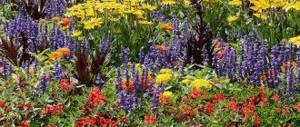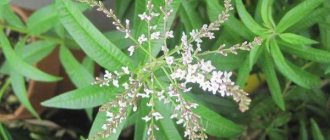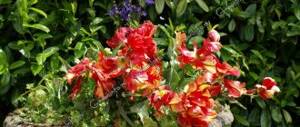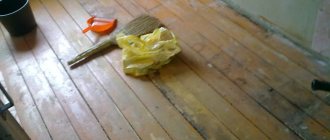Simple, but so bright and colorful asters are well known to all gardeners. They are used for cutting or for constantly blooming flower beds, which continue to delight even in rainy autumn. Are you interested, but don’t know where to start creating your own seedlings? We are ready to talk about the main features, subtleties of care and variety of types of decorative asters!
general characteristics
The reason for the popularity of asters is not only their unpretentiousness, but also their late flowering. In the summer, they hardly attract attention against the backdrop of lush green seedlings, but in the fall, multi-colored stars will decorate any composition. Perennial asters are asteraceous herbaceous plants that are distributed throughout the world, from Europe to Africa and America. There are more than two hundred varieties with characteristic inflorescence baskets. But this is how the annual garden aster belongs to another family - the Callistephus.
Asters in landscape design
When using asters in landscape design, it is important to pay attention to their size. Different varieties of asters can be from 25 to 80 cm in height. Tall asters can be used as the center of a composition or among flowers of the same height. Use dwarf asters as accents or background.
Low asters for an alpine slide
Asters can be used for alpine slides, flower beds and mixborders. Asters of medium height can be combined with yarrows and ornamental grasses. Low-growing asters are “friends” with marigolds and carnations.
Aster is a magnificent garden decoration. Simple rules for caring for a flower make it truly popular.
Asters in landscape design
Types of asters
All asters are classified into annual and perennial, and all of them can be compact potted, long-flowering planted, decorative cut or universal. Annual asters also differ in the shape of their petals: tubular, reed or transitional.
Alpine aster
The perennial alpine aster is one of the most common in gardens and summer cottages. This is a small compact shrub up to 30 cm, which is used to decorate borders, paths and decorate the edges of flower beds. Flowers up to 5 cm in diameter can be purple, pink, red, white, lilac and even blue.
New England aster
A tall autumn variety easily reaches 2 meters in height, so it can become the center of a decorative composition. Lush brushes consist of several dozen relatively small flowers - 3 cm in diameter. They bloom in purple, lilac, pink and white by September.
Italian aster
The bright tall aster is also called chamomile and stretches up to 60 cm. It can be used not only as a fence, but also as independent single bushes. The flowers are collected in pink, purple or blue corymbs, which bloom towards the end of July.
Astra Andersa
The perennial spring aster blooms earlier than its relatives and blooms with a lush purple color. Low-growing shrubs reach 40-50 cm, and the smallest varieties resemble colored field daisies.
New Belgian aster
The tall autumn aster reaches 1.5 meters, but there are also compact, low-growing varieties up to 40 cm. Pink or purple flowering panicles bloom in September on woody stems. They are so thick and lush that sometimes you can’t even see the foliage behind them.
Bessarabian aster
In fact, it is a popular subspecies of the Italian aster and is often classified as its own. Its peculiarity is large flowers with a pronounced brown core.
Bush aster
A compact perennial shrub up to 40 cm blooms before the first frost. These are white or light purple flowers that create bright and fluffy caps. It comes from North America, and the thick and lush foliage looks impressive even when the bush is not blooming.
Callistephus
The garden or Chinese aster callistephus is the closest relative of the perennial. It looks similar to chrysanthemums, dahlias or other flowers, which is why they are often confused. In fact, this is a whole family with a separate classification into early and late, dwarf and giant, double and non-double, coronal, curly, spherical, hemispherical or needle-shaped.
Caring for asters
Growing asters is very easy, and caring for them is simple and straightforward, so anyone can do it. The main thing is to loosen the soil and regularly weed, and then the flower will feel good and delight with its beauty.
Temperature
Asters are heat-loving flowers, but they feel quite comfortable in our latitudes. It is recommended to transplant seedlings when the temperature is already stably maintained above +6 degrees. The optimal temperature for seedlings is 20-22 degrees, but when the seedlings sprout it needs to be lowered to 16 degrees. Perennial asters will have to be dug up and replanted for the winter, but they can be propagated by division. In the process, it is important not to damage the root system - and then the flower will quickly adapt to a new temporary location.
Lighting
Most decorative varieties of asters are unpretentious to lighting, so they feel good both in the sun and in the shade. It is precisely this versatility and undemandingness to external conditions that have made asters such frequent residents of country gardens.
Watering
Asters prefer moderate humidity, so it is important not to overdo it, but also not to dry out the soil. In hot summers, it is better to reduce the frequency of watering, but make it more abundant: up to three buckets of water can be used per square.
Fertilizers and fertilizing
Asters need to be fed a few weeks after transplanting into open ground, and after another month, repeat the procedure. To do this, just specialized complex fertilizers are enough - and the flowers will be lush and beautiful. Additional feeding is needed during the formation of buds and after the start of flowering, which takes a lot of resources. The soil for asters must be well mulched with peat, bark or sawdust. Flowers love loose and breathable soil, in which there are fewer weeds and moisture is better absorbed.
Trimming
Additional care depends on the specific variety of asters: tall ones can grow up to 2 meters and require a garter. Thin tall pegs are used as support, or flowers are immediately planted along the fence. And bushy asters need to be trimmed periodically to form a beautiful and elastic crown: this way you can even make a full-fledged hedge from them.
Planting aster seeds
Also check out these articles
- How to light a smoker for bees
- Raspberry compote
- Breed Italian geese
- How to plant raspberries in spring
Although there are many methods for propagating asters, they are most often grown through seeds. This method is especially recommended for propagating alpine aster. Sow seeds for seedlings in March. If you don’t want to grow seedlings, you can immediately sow them in open ground. In the southern regions this is done in early April, in the middle regions by mid-April, and in the northern regions - closer to May.
Photo of aster: planting and care
Important!
If return frosts begin after sowing the seeds, the soil on the plantings is well mulched or covered with film so that the seeds do not freeze.
It is best to sow perennial asters in loamy soil. Sandy soil, as well as heavy, clayey soil, is not suitable for them, because in the first case, there will always be not enough water, and in the second, there will be too much of it. Asters produce rich flowering exclusively in sunny areas, while in the shade they produce more lush foliage. It is also worth mentioning that tall perennial asters are afraid of drafts.
As for the sowing method, there is nothing difficult here. Asters are sown in a sparse single file in a furrow to a depth of 3 cm. After sowing, it is necessary to ensure that the air temperature is about +15 degrees, then seedlings will appear faster.
Planting and propagation of asters
To have time to prepare the soil for planting asters, do this in the fall, otherwise you are unlikely to have large and fluffy flowers sprout. They need moistened and fertilized soil, into which humus has been added in advance. Annual asters are planted directly from seeds - this is the easiest way and they germinate well both in seedlings and without seedlings. If something goes wrong, you can reseed after first studying the quality and composition of the substrate.
To sow in the ground, the seeds are scattered in small shallow furrows, lightly sprinkled on top and covered with soil. You can thin out future bushes when at least three leaves have already appeared and become stronger. Asters do not have to be pulled out: they can simply be carefully planted at a distance of 5-7 cm. If you grow seedlings in a greenhouse, transfer them to the beds only after the root system has developed and when the height of the bushes is at least 10 cm. Perennial asters sometimes require replanting, which is held in winter. And it is easier and faster to propagate them by cuttings using young shoots that appear on the stems in the warm season. They quickly take root and grow into fluffy and strong bushes that feel great in gardens and rose gardens.
Landing place
Perennial asters love loamy or neutral soil, while annual asters prefer areas of land with a high sand content and a small amount of humus. You should not plant plants in overly shaded areas, as if the shade is thick, they may begin to hurt.
Large red asters planted near the house
How to sow asters?
Sow seeds in spring. To do this, dig up the ground in the fall, adding about 200 g of nitrophoska and a bucket of compost per square meter. There should be little sun on the site, but lowlands should also be avoided. Every year you need to change the place where asters are planted, since substances that have a particularly bad effect on the bush accumulate in the soil and remain active for several years.
The sown land is covered. The cover is removed periodically to allow the sprouts to harden. When the warm temperature is finally established, the beds are opened completely.
Aster seeds are sown in spring
Growing aster seedlings
Planting aster through seedlings is a more labor-intensive task. But the presence of an intermediate period helps protect the bush from annoying viruses that lie in wait for the plant.
For seeds, you can buy ready-made soil or prepare it yourself. To do this you need to do the following:
- mix the soil with peat and washed sand;
- add tree resin (100 g per 5 liters of mixture) or dolomite flour (1-2 spoons for the same volume);
- sift and steam the mixture;
- It is also advisable to add 100 grams of perlite to the mixture.
Aster seeds do not have to be sown directly into the ground - you can plant seedlings
To prevent the development of fusarium (we will talk about this disease of aster below), the mixture is soaked with a fungicide solution. The seeds are also treated with it before planting.
The evenly sown soil is covered with sand, which soon becomes wet. As with sowing seeds in the ground, the seedlings are covered. When the leaves become more or less noticeable, the sprouts dive. A spoonful of mineral fertilizer is added to the soil recipe we are already familiar with. Having strengthened the flowers in the holes, they are watered.
Aster seedlings need to be fed and fertilized
Seedlings are planted when the sprouts already have 4-5 leaves. Before planting, the soil should be additionally fertilized with humus or compost, and the seedlings themselves should be watered thoroughly. After a week, young plants are fed with complex fertilizers, and then this operation is repeated after three weeks.
Asters planting time
Typically, aster seeds are planted in early spring, seedlings - in mid-May.
Advice! If you missed the spring time, use cuttings, which are allowed to be done all summer. To do this, you need to cut off 5-7 cm of the top of the plant, plant it in sandy-peaty soil (1:1:2) and keep it in a greenhouse. In a month you will receive a full-fledged aster bush.
Aster flower seedlings are planted in the ground in mid-May
Rules for caring for asters
Caring for asters in the garden involves watering, maintaining loose soil and weed control. The bush should be fertilized no more than twice per season so as not to cause disease.
Watering and loosening are interconnected: after the first action, it is necessary to carry out the second. But don’t get carried away: water the bush infrequently, but in large quantities. If the weather is dry, as well as during the growing season, the amount of water can be increased, but do not go too far.
Aster needs to be watered rarely, but abundantly
During the season, the aster is fed 3 times. For the first watering, which occurs two weeks after planting, use a mixture of nitrate (20-25 g), superphosphate (50-60 g) and potassium sulfate (10-15 g) per 1 m².
The next two feedings are timed to coincide with the appearance of buds and the beginning of flowering. The amount of potassium sulfate in the mixture increases to 50-60 g/m².
Delicate pink asters in a summer cottage
Pest and disease control
Asters are easy to care for, but are sensitive to some characteristic diseases. For example, they cannot be planted in areas where nightshade or some other flowering crops have grown for at least 5-6 years. The most common of them is fusarium, caused by fungi from the genus of the same name. It is almost impossible to cope with the problem, because the flowers turn yellow and wither too quickly. But it can be prevented if you treat the soil and seedlings in a timely manner. The second common fungal infection is black skin, caused by rotting of the root collar. It develops in acidic soil: the seedling turns black and withers. To combat the problem, remove all affected plants as quickly as possible and treat the soil with potassium permanganate or special products.
If the leaves lighten and turn yellow, this is the so-called jaundice, which is carried by cicadas and aphids. It suppresses the growth and development of the plant and prevents flowering. It is important to treat seedlings with insecticides in a timely manner and completely remove damaged flowers. Asters do not tolerate proximity to coniferous plants - because of this, rust may appear on the leaves. Powdery mildew occurs less frequently, but special series have been available to combat it for a long time. The main pests of asters are earwigs, spider mites, slugs, aphids, pennies and meadow bugs. For prevention, do not forget about careful digging, removing annual plants, fertilizing the soil and maintaining the distance between seedlings.
Asters – photo
Asters, for all their simplicity, amaze the imagination with their variety of shapes and colors. If you are still in doubt, we have put together this selection of photos with the most beautiful and graceful “star” flowers.











